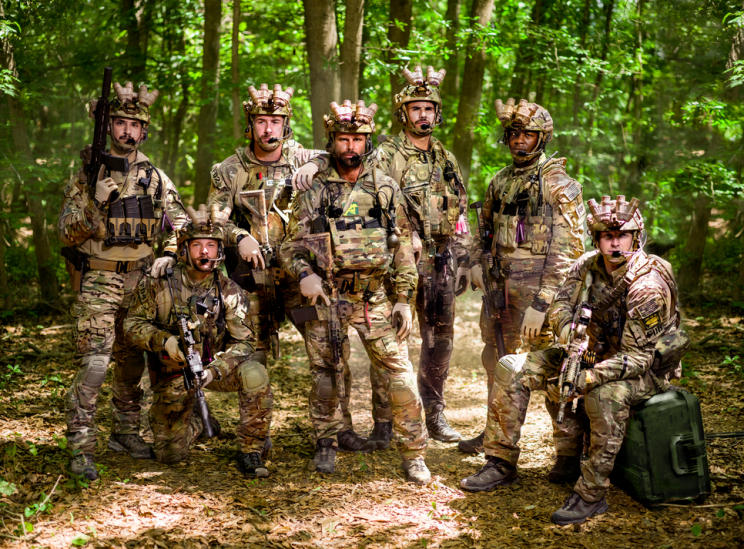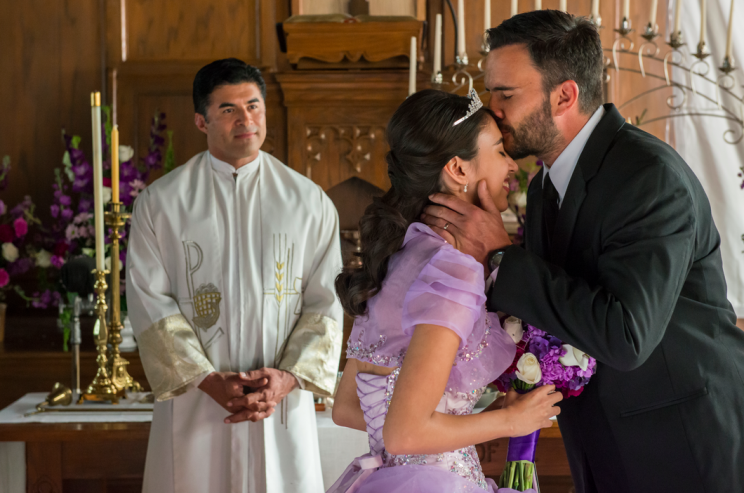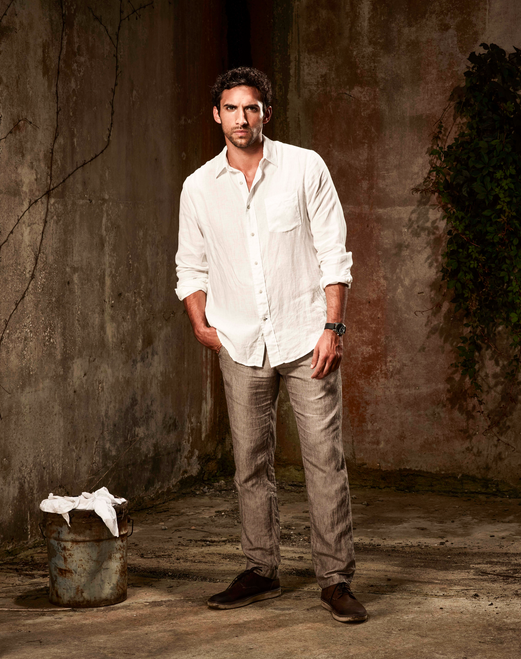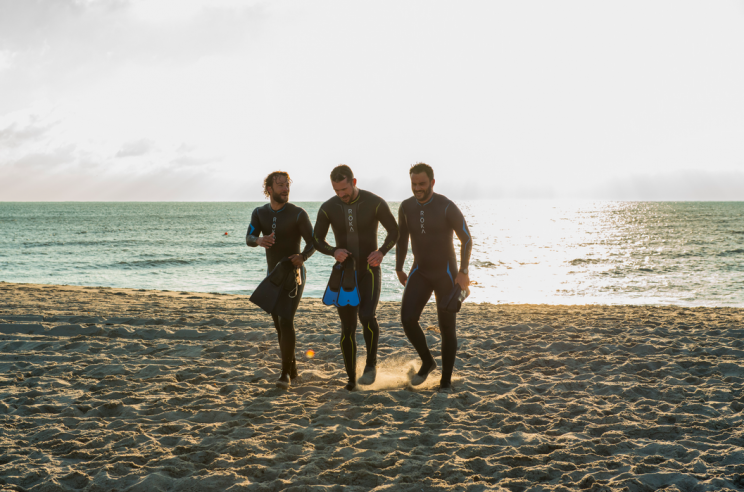History’s ‘SIX’: 5 Things to Know About the Navy SEAL Drama Starring Walton Goggins

In History’s drama series SIX, premiering Jan. 18, Justified‘s Walton Goggins stars as Richard “Rip” Taggart, a former Navy SEAL Team Six leader turned gun-for-hire who’s captured by Boko Haram alongside the students and teacher of a girls’ school in Nigeria. The men formerly under his command, now led by his protégé, Barry Sloane’s Joe “Bear” Graves, request the rescue mission.
Yahoo TV spoke separately with Goggins and David Broyles, a military special operations vet who co-created the series with his father, screenwriter William Broyles Jr. (Jarhead, Apollo 13), to discuss the heart of the eight-episode season. Here are five things you need to know going in.
1. The story isn’t just about the rescue mission. “It’s about the SEAL family and the home family and the push and pull between those families,” David says. As opposed to most soldiers who go on long deployments, “These guys will go on missions like other people go on business trips,” he says. “One day they will be at a fertility clinic, and then, 24 hours later, they’ll be parachuting into an ocean to take down a terrorist. After they do that, they’re back home 24 hours later. It’s the challenge of maintaining both worlds, when you’re crossing between them so often and so viscerally.”
Showing the home lives of the SEALs offers a full picture. “A lot of these movies and shows about SEALs show them as superheroes,” Broyles says. “We get to see them as the Michael Jordans of special operations: We see them play the game, and they’re shooting three-pointers, they’re dunking from the free-throw line, but we don’t get to see what happens before and after that. To me, that does a disservice to the men and their families, because they’re not superheroes and they’re not bulletproof. They’re human, and they have these issues they deal with that we could recognize. Our goal was to humanize them and show that they are people like us doing an incredible job under extraordinarily challenging circumstances, and to me, that’s always what made them heroic.”

2. The series explores the human price that SEALs pay. The series begins two years before Rip’s kidnapping, when he’s still with the team and crosses a line on a mission in Afghanistan. “He loses a sense of who he is and what he represents and what he was fighting for,” Broyles says. “He needs to rediscover his identity. The way he does that is through the innocence of these school girls and Na’omi [their teacher, played by Nondumiso Tembe]. Of course, the irony is that he thinks he’s saving Naomi and the girls, but really, they end up saving him.”
That slow journey is what attracted Goggins, who replaced Joe Manganiello in the role of Rip after Manganiello fell ill early on during filming. As Goggins remembers, when he first spoke with David Broyles and his father, and fellow executive producer/writer Bruce C. McKenna (Band of Brothers, The Pacific), they told him Rip had done some “questionable things.”
“I said, ‘Rip is a war criminal. You can say what you want to say, but that’s what he is, so let’s start from the truth. Let’s start from that point and how did he get there, and what is his emotional state when you meet him, and ultimately where do you want to take him? For me, I want to go on a journey of personal redemption and one that takes into consideration the havoc that war has reaped on his soul.’ They were more than willing to go there,” Goggins says. “I felt like I could honor the men and women in our armed forces if I could capture, for a moment, the isolation and the anger and the frustration that they feel, and when no one’s looking, the regret or the remorse or the jubilation. If I could effectively communicate this complex series of emotions that I might be able to do some good — that a man or a woman who has served this country might, for a minute, watch this show and think, ‘You know what? I felt like him. He’s speaking to me right now.’ That’s really what I wanted to do. … I think the conversation has to center around what the theater of war can do to a human being. I felt like that’s the way that I could add to this conversation. It became very, very personal to me, and a real opportunity to, in some ways, bring about a little bit of healing for someone.”

3. As important as it was to honor and humanize the SEALs, it was also important that the show’s main “villain” — the Muslim-American terrorist, Michael (Dominic Adams), who has a personal reason for wanting to reach the captive Rip himself — have a similar depth as the season approaches its final hours. “These are all people, and we’re operating where there is no black and white. Things are complex and complicated, and it does extend to Michael,” David Broyles says. “We believe an audience is hungry for that kind of provocative, challenging television.”
Goggins agrees. “I said to [the producers], ‘The story is the most important thing to me, and I can tell you right now that if Michael’s journey is not just as important as Rip’s journey, then we have failed. It will just be another piece of propaganda. But if we can humanize the other person on the ideological spectrum, if we can look at him and treat him as respectfully as we treat Rip and the Navy SEALs, then we will have done something that very few people have the courage to do,” he says. “Michael is very similar to Rip: He is a person fighting his own ideological war, and when you take the politics out of it, you take religion out of it, he’s a human being in the world affected by what his own morality dictates that he does. It’s time to examine that.”
That’s why we’ll see Michael and Rip have lengthy discussions. “There are multiple conversations between Rip and Michael, and there is an episode in particular, Episode 7, where you get to see a beginning and a middle and a beautiful end to their story,” Goggins says. “They see each other and they listen to each other in a way that we should all be motivated to do. … I think we collaborated in a way that we all felt like we were doing something bigger than ourselves. That’s how you want to end every day, man.”
4. A Muslim-American SEAL in the show, Armin “Fishbait” Khan (Jaylen Moore), was modeled on Broyles’s late team leader. “It was really important to show that there can be Muslim-American heroes, because I was mentored by one,” he says. “Especially when we’re dealing with a Muslim-American antagonist, it’s important to show that this is a personal choice in either direction.”

5. While Goggins only had three days to prep to play Rip (they reshot the character’s scenes in Episodes 1 and 2 and went right into Episode 3), the rest of the actors playing SEALs had gone through training together before filming began. How the actors performed informed their roles: “Kyle Schmid [who plays Alex Caulder] was a natural athlete, and he took to the training pretty quickly, and that really fit with Caulder’s character, who things come more easily to, so we incorporated that a little bit,” Broyles says. “Barry Sloane, an Englishman, reached his breaking point during the training, just like everybody else did, but he pushed through it, and we figured out that Graves is a grinder — he is going to push through, kind of like Barry did. And then there’s [Ricky “Buddha”] Ortiz [played by Juan Pablo Raba], who we always thought was going to be the glue of the team, and Juan Pablo exemplified that. He was the guy who kept everybody together.”
At that time, Broyles was location scouting in North Carolina (Season 1 was filmed in Wilmington, Del.), and he received reports every few hours from the show’s technical advisor, Mitch Hall, a retired Navy SEAL who also worked on the films Zero Dark Thirty and Lone Survivor. One day, Jaylen Moore (aka Fishbait) injured his knee during training and spent hours hopping on one leg and being carried by the others. “I didn’t know if they were going to call their agent and be like, ‘We’ve had it. We’re leaving,'” Broyles says. “We were pushing them to their limits, and one of the things we wanted to see was if they would come together in the face of adversity. The whole goal was to really create the bond and the brotherhood as quickly as possible, and I’ve found personally, there’s two ways to do that: One is to maybe get in the boxing ring and trade punches, or two is shared suffering. To hear that they were coming together in that moment with Jaylen was really reassuring. At that point, I knew that they were going to make it.”
SIX premieres Jan. 18 at 10 p.m. on History.


